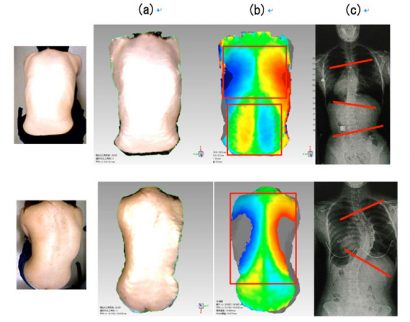Researchers develop new system to detect spinal deformity
Posted: 22 November 2016 | Niamh Louise Marriott, Digital Content Producer | No comments yet
Hokkaido University researchers have developed a spinal symmetry-recognition system that can 3-dimensionally detect early stages of idiopathic scoliosis…


Hokkaido University researchers have developed a symmetry-recognition system for the surface of the human back that can three-dimensionally detect the early stages of idiopathic scoliosis, a type of spinal deformity, without the help of a specialist doctor.


Image analyses of idiopathic scoliosis sufferers using a three-dimensional, back-surface-symmetry-recognition system Top: images of a case in which a patient is to be treated with a brace. The thoracic vertebra curves by 34 degrees. Bottom: images of a case in which a patient requires surgery. The thoracic vertebra curves by 60 degrees. (a): a three-dimensional image of the back’s surface (b): based on image (a), the system evaluates the degree to which a patient’s back deviates from the ideal symmetry for a human back within a few seconds. The larger the deviation, the deeper the colour. (c): comparison to X-ray photos. Deviations in the image correspond with curvatures. Images: Hokkaido University/Noa Co
Early detection of the progressive ailment is regarded as essential for treatment, as it is effective to wear a special brace when the spine is curved by 30 degrees or more. In recent years, genetic study of the disease has progressed, boosting the development of treatments.
Individuals with idiopathic scoliosis, many of whom are pubescent girls, suffer from serious curvature of the spine. The disease has a characteristically high affliction rate, affecting one in 50 people.
In accordance with stipulations in the Japanese School Health and Safety Act, elementary and junior high schools conduct physical check-ups aimed at detecting idiopathic scoliosis.
However, the law leaves it up to the respective medical associations or education boards in each municipality to decide how to conduct the checks, giving rise to regional gaps in the detection rate. Another related problem is the burden placed on doctors who have to examine a large number of students within a limited time frame.
Developing a solution
To address these issues, two scientists from different fields of research, Associate Professor Hideki Sudo of Hokkaido University’s Graduate School of Medicine and Professor Satoshi Kanai of the Graduate School of Information Science and Technology developed a system to evaluate the level of asymmetry on the surface of the back when measured three-dimensionally.
In a collaboration between the university and Noa Co, the researchers developed a prototype device for detecting idiopathic scoliosis. The device is expected to go through clinical testing so that it can be used in clinics and for physical examinations at schools.
Scans multiple points
The device three-dimensionally scans multiple points on the back, enabling the evaluation of the back’s symmetry from any angle in a few seconds. In this way, it is expected to enable speedy and accurate detections of idiopathic scoliosis.
In the future, the researchers hope to gain government approval for the clinical use of their device.
Related organisations
Hokkaido University, Noa Co


